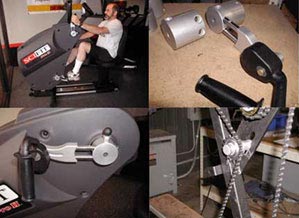Training quietly
"Thanks to iglidur® plastic bearings and igubal® rod end bearings, the company was able to save at least 15,000 U.S.$ a year in production costs and considerably reduce assembly times."
Pivot bearings were necessary for the chain tensioners on all training equipment. The machine has a drive train that consists of top and bottom pedal cranks for arms and legs. The pedal cranks are linked and drive a resistance load via a roller chain. So that the alignment between the teeth on the sprocket is ensured, the axial position was adjusted and varied from machine to machine. This increased the assembly time and made work complicated for service engineers. When the teeth wear down, this caused a dynamically varying chain line during operation, which resulted in excessive noise and the possibility of the chain jumping out.
Using iglidur® W300 bearings in the chain tensioner enables both the axial and rotary motion of the roller. This prevents the need for time-consuming alignment during assembly. The result is faster assembly, easier servicing and no more chains jumping out.
Furthermore, 4 iglidur® W300 plain bearings are used on the training equipment to adjust the crank arms on the part of the appliance for the upper body. The earlier design required a high degree of precision, which could not be achieved mechanically. The leveling was therefore done by hand in order to level the crank arm clips with the corresponding dovetail slots. Every little bend or misalignment due to a knock affected the performance of the adjusting mechanism. Maintenance was extremely difficult and the adjusting slots on the back of the crank reduced the strength of the crank arms, which often led to breakdowns during high load applications.
As a solution, parallel guide rods were designed, which allow a torsion-resistant linear motion. iglidur® W300 bearings were used for each rod in pairs with a gap between them in order to enable a linear motion with low friction, high endurance and minimal room between bearing and rod. Stiffness is achieved due to the low installation height, noise is minimized and the steel rods are less prone to damage. All crank arms can be connected with each cam mechanically, meaning there is no more need for manual adjustment.
A third application on a totally new piece of training equipment contained a crank arm with a dynamically variable length for use on a training bike. It varies during a cycle depending on the user's feet position by means of a cam and guide roller. An earlier prototype optimized an expensive, customized series roller plain bearing, but this solution repeatedly failed due to the constant misalignment, deflection and noise level. The change in size of the design proved too expensive. The solution was to find an appropriately durable, rigid and tool-free design.
A design was developed consisting of a crank arm bearing with a set of iglidur® W300 ball bearings, which slides along on a pair of parallel steel rods. This also contains an igubal ball bearing, which activates a steel pin that is fastened to the crank arm bearing. The crank arms are now sufficiently rigid and a misalignment due to inaccuracies in the bike frame and the subassembly, as well as stress caused by the user, is compensated without exerting extreme loads on the machine and crank mechanism, as was the case on earlier prototypes.
